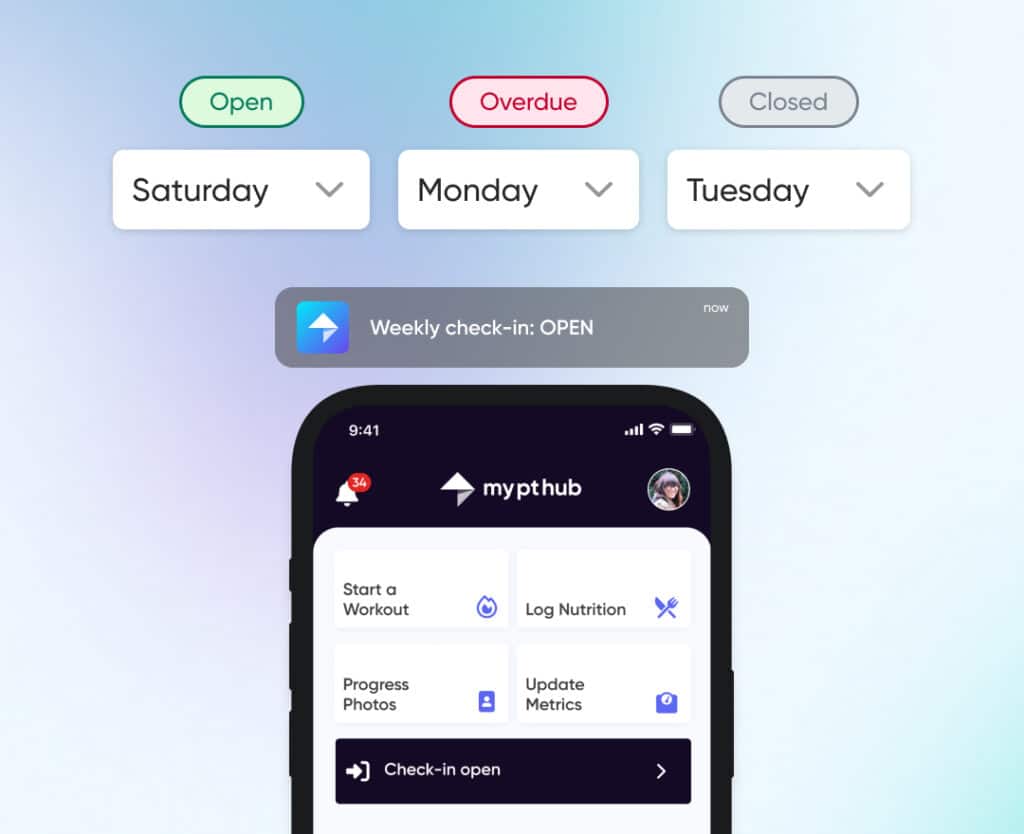If you’re looking for fitness challenge ideas that actually get clients moving and staying accountable, you’re in the right place. A well-designed fitness challenge can spark motivation, build momentum, and strengthen your coach-to-client relationship, especially when it’s easy to roll out at scale.
This guide gives you a wide variety of challenge formats to use with individuals, small groups, or your entire client base. You’ll find repeatable, goal-driven ideas designed to increase retention, build community, and keep your programming fresh throughout the year.

What are the most popular types of fitness challenges?
Before planning your next challenge, it helps to understand the formats that consistently drive results. The strongest fitness challenges are simple to follow, easy to customize, and give clients a clear reason to show up.
Here are five of the most effective challenge types personal trainers use to engage clients, encourage consistency, and build habits.
1. Workout challenges
Best for: Building commitment to regular training
These challenges ask clients to complete a specific number of workouts within a set timeframe, such as “12 workouts in 30 days” or “train 4 days per week for 6 weeks.” You can scale these up or down based on fitness level, goal, or training style.
Examples:
- 3-workout streak every week for a month
- 30-day movement calendar with full-body workouts
- “Beat the clock” challenges with timed finishers
2. Habit-based challenges
Best for: Developing consistency beyond the gym
Habit-based fitness challenges focus on repeatable behaviors rather than performance. They are especially helpful for beginners or lifestyle clients looking to create healthy routines in areas like hydration, sleep, or step counts.
Examples:
- 10,000 steps every day for 30 days
- Daily mobility streak (5 to 10 minutes per day)
- Build-a-habit challenge, pick one habit and track it for 21 days
3. Performance challenges
Best for: Goal-driven clients who thrive on metrics
These challenges focus on improving a specific physical skill or benchmark. They are ideal for clients who respond well to tangible results and like tracking their progress over time.
Examples:
- Max push-ups in 60 seconds
- Deadlift 1.5x bodyweight within 6 weeks
- 5k time trial with weekly pace targets
What makes a fitness challenge successful?
A successful fitness challenge goes beyond just ticking boxes. It should motivate clients to stay consistent, feel part of something bigger, and see real progress by the end. When done well, challenges can become a cornerstone of your coaching strategy, not just a one-off event.
Here are five key traits that drive fitness challenge motivation and long-term success:
1. A clear and meaningful goal
Every challenge needs a specific outcome. That could be completing 12 workouts, increasing step counts, or improving a benchmark lift. The goal should be simple to understand, measurable, and relevant to the client’s journey.
2. Visible progress and quick wins
Clients stay motivated when they see results. Build in regular checkpoints or small milestones to keep them on track. For example, celebrate weekly streaks, habit streaks, or percentage improvements in performance.
3. Built-in accountability
Challenges work best when clients feel seen. Use regular check-ins, shared progress tracking, or team-based formats to help participants stay engaged and consistent.
4. The right level of difficulty
Too easy and clients disengage, too hard and they burn out. Tailor the challenge to your audience’s fitness level, and offer tiered versions if needed. This makes your challenge more inclusive and sustainable.
5. A sense of community or fun
Even solo clients benefit from shared energy. Group messaging, leaderboards, or team goals can create connection and healthy competition. Bonus points for challenges that feel enjoyable, not just obligatory.

Fitness challenge ideas for groups, teams and clients
Running fitness challenge ideas for groups is one of the most effective ways to build community, boost accountability, and inject energy into your coaching. Whether you’re managing a group program, coaching a gym class, or working with friends online, a well-structured team fitness challenge can turn individual effort into shared momentum.
Here are some of the most engaging group fitness challenge ideas to run with teams, training pods, or your wider client base:
1. Team target tracker
Challenge: Each team must hit a collective target within a set timeframe (e.g. 5,000 burpees in 30 days, or 1 million steps in 2 weeks).
Why it works: Encourages teamwork, daily participation, and fair contribution from all fitness levels.
2. Fitness bingo
Challenge: Create a 5×5 bingo card of tasks (e.g. “train with a partner,” “run 2k,” “hit 8 hours of sleep”). Clients aim to complete rows or full cards.
Why it works: Adds variety, sparks conversation, and keeps things playful across different goals.
3. Points-based leaderboard
Challenge: Assign points for activities (e.g. 5 points per workout, 2 points per habit ticked). Teams or individuals accumulate points over a challenge period.
Why it works: Adds friendly competition while rewarding both effort and consistency.
4. Partner AMRAPs
Challenge: Clients pair up and complete “as many reps as possible” workouts where one works while the other rests. You can run this live or remotely with synced tracking.
Why it works: Builds accountability between pairs, and encourages intensity with shared responsibility.
5. Accountability squads
Challenge: Small groups check in weekly on workouts, habits, or goals. You can run this through group chat threads or short video calls.
Why it works: Boosts consistency and creates a support system, especially for clients training remotely.
6. Challenge with friends
Challenge: Invite clients to bring a friend for a set challenge period, such as “Train together twice per week for 4 weeks.”
Why it works: Brings in new leads and adds social motivation. Works well for hybrid or in-person PTs offering referral bonuses.
30-day, weekly and monthly challenge formats
One of the easiest ways to keep clients on track is by using time-based formats. These repeatable structures, like 30 day fitness challenge ideas or weekly fitness challenge ideas, give clients a clear time frame, measurable targets, and a sense of urgency.
They’re also easy to recycle across different focus areas like strength, mobility, or mindset.
Here are proven daily, weekly, and monthly fitness challenge ideas to use throughout the year:
30-day fitness challenge ideas
Perfect for habit-building and seasonal campaigns
- 30-day full body blast: Four workouts per week, increasing intensity each week
- 30-day daily movement: Walk 8,000+ steps or complete 20 minutes of movement each day
- 30-day strength ladder: Choose one lift and add reps or weight every week
- 30-day stretch and recover: Daily mobility routine plus one longer recovery session per week
30-day mindset boost: Daily gratitude, journaling, or self-check-in tasks
Weekly fitness challenge ideas
Best for consistency and short-term commitment
- Workout streak challenge: Train three times per week for four consecutive weeks
- Weekly progression plan: One workout repeated each week with added reps or reduced time
- Weekly mobility and strength pairing: One strength session plus a mobility goal each week
- Theme week challenge: Rotate weekly focuses (e.g. core week, glute week, conditioning week)
- Track and improve: Log one metric (e.g. RPE, distance, time) and aim to improve it weekly
Monthly fitness challenge ideas
Great for longer-term programming and visible progress
- Monthly fitness benchmark: Set and retest a benchmark workout (e.g. timed circuit or lift)
- Monthly mileage club: Total distance covered via walking, running, cycling, or rowing
- Monthly consistency challenge: Hit 85% or more of scheduled workouts for the month
- Monthly habits streak: Track one lifestyle habit daily and review at month-end
- Monthly mind and body reset: Combine workouts, mindset work, and nutrition focus into one holistic challenge
Daily fitness challenge ideas
Great for discipline, routine, and low-friction participation
- Daily step target: 10,000+ steps logged each day
- Core every day: 5 to 10 minutes of core work daily
- Mindful mornings: Start the day with one intentional action (e.g. breathwork, cold shower, gratitude)
- Hydration challenge: Hit water targets daily and track with a simple log
- Sleep routine tracker: Wind-down tasks or screen-free time before bed

Fun and beginner-friendly challenge ideas
Not every client wants to chase PBs or hit intense goals. Sometimes the most effective way to get someone moving is to make it fun, simple, and low-pressure.
These fun fitness challenge ideas are perfect for newer clients, people returning after time off, or anyone who thrives on variety and light competition. The key is to remove friction, reduce intimidation, and make participation feel enjoyable.
When it comes to fitness challenges for beginners, a focus on accessibility is crucial. Choose bodyweight movements, daily tasks, or mindset-based goals that create quick wins. A “7 Days of Movement” challenge, for example, could include a different low-impact activity each day, such as walking, yoga, or dancing.
Another great format is a “First 5 Challenge,” where the client does five minutes of intentional movement daily, gradually increasing duration or intensity over time.
To add a social element, try “Fun Friday Challenges” where clients complete a silly or playful task before the weekend. This could include balancing exercises, themed dress-up workouts, or workout bingo.
Fun fitness challenges like these work especially well in group settings where laughter and interaction can drive motivation just as much as results.
Here are some additional fitness challenge ideas for beginners:
- A 21-day hydration tracker with a visual progress sheet
- Daily step goals that start at 5,000 and increase weekly
- “Habit stacking” challenges that pair movement with routines, like stretching after brushing teeth
- Low-impact circuits that use only a mat and a timer
- Social media prompts like “Post your workout spot of the day” to build community
These formats can be delivered individually or as part of a group program, helping newer clients ease into training without overwhelm or pressure.
Creative exercise and physical challenge ideas
When clients hit a motivation plateau, fresh exercise challenge ideas can reignite their interest and help them break out of routine. These formats lean into variety, skill-building, and gamification.
They’re especially useful for clients who enjoy trying new things or need a break from linear programming. For coaches running hybrid or group sessions, fun workout challenges like “Deck of Cards” workouts or “EMOM Gauntlets” can be a great way to bring energy into a class or virtual training block.
One effective approach is to base exercise challenges on patterns rather than intensity. For example, a “Movement Alphabet” challenge asks clients to complete one exercise for every letter of their name or the alphabet.
A “Workout Dice” format assigns a different movement to each number and invites clients to roll for randomised circuits. These gamified formats keep things playful and unpredictable while still delivering a solid training stimulus.
Creativity also means changing how you define a challenge. Instead of reps or time, ask clients to focus on environment, style, or tempo.
Try “Silent Workouts” where no music or distractions are allowed, or “Tempo Builders” that slow each movement down for maximum control. These challenges can build awareness and focus, helping clients become more intentional with their training.
Here are a few more creative ideas:
- Partner challenges where one person works while the other holds a static position
- “Dice day” circuits with randomised movements, durations, or intensities
- Unilateral strength challenges like single-arm carries or single-leg squats
- Bodyweight ladder workouts (e.g. 1 to 10 reps, then back down)
- Timed mobility flows combining yoga-inspired movements with strength holds
By switching up the structure, setting, or style, you can keep challenges feeling new without reinventing your entire program. The goal is to keep clients curious, engaged, and excited to participate week after week.
Physical and movement-based challenges
If you’re looking to push clients with more hands-on, goal-driven tasks, physical challenge ideas can provide a clear sense of progress and accomplishment.
These challenges focus on movement, endurance, balance, or coordination and can be scaled for different fitness levels. They’re especially effective for in-person sessions or hybrid programs where form and function can be closely monitored.
Classic physical challenges like wall sits, plank holds, or agility drills work well as timed efforts or progressive tests. You can also introduce mini obstacle-style tasks that combine cardio and strength.
For example, set up a “Core Gauntlet” challenge with five bodyweight movements, or a “Balance Flow” that blends yoga and strength poses into a continuous sequence.
When creating physical challenges for adults, aim for formats that feel achievable but still push limits. Use low-equipment or bodyweight tasks to keep accessibility high and admin low.
For instance, a “No-Equipment Endurance Test” might involve squats, push-ups, and mountain climbers completed for max reps in five minutes. Add variety with tempo changes, movement combinations, or circuit progressions.
Some popular fun physical challenges for adults include:
- One-minute max hold series (plank, wall sit, hollow hold)
- Agility ladder drills for time or accuracy
- “Around the World” bodyweight circuits with one exercise per muscle group
- AMRAPs with a twist (e.g. complete in reverse order, no rest between rounds)
- Partner challenges with resistance bands or manual resistance
These challenges can be used as standalone tests, end-of-program finishers, or benchmark events throughout the year. As well as testing physical ability, these challenges create a shared sense of achievement and progression across your client base.

How to build a recurring fitness challenge schedule
Once you’ve tested a few ideas, the next step is to create a recurring structure that keeps clients engaged over time. A consistent rotation of weekly fitness challenges and daily fitness challenges can help clients build habits, look forward to what’s next, and stay active between program blocks or check-ins.
Here’s a simple framework you can adapt for monthly, quarterly, or ongoing cycles:
1. Choose a recurring format
Pick one challenge format per timeframe (e.g. daily habit, weekly workout, monthly progression). Keep it predictable but not repetitive. For example:
- Daily: Movement, mobility, or mindset
- Weekly: Strength, performance, or workout streak
- Monthly: Challenge milestone or test and retest
2. Use themes to keep it fresh
Create challenge “seasons” with different themes. Rotate focus areas like:
- Strength
- Cardio and endurance
- Recovery and mobility
- Nutrition and habits
- Mindset and lifestyle
This helps your content feel varied and intentional, even if the structure stays consistent.
3. Build in reflection and resets
End each cycle with a short review, client check-in, or debrief. Ask what worked, what could be improved, and where to go next. This boosts accountability and shows clients you’re invested in their progress.
4. Automate what you can
Recurring daily fitness challenges and habit trackers are easy to automate with the right tools. That keeps your coaching time focused on support and feedback, not setup and reminders.
Wellness and lifestyle challenges to support healthy habits
Not every challenge needs to be workout-focused. For many clients, long-term progress comes from building better routines around sleep, stress, nutrition, and recovery. These wellness challenge ideas help shift the focus to consistency and self-awareness, giving clients tools they can use well beyond the gym floor.
Running a personal wellness challenge can be as simple as asking clients to check off three daily actions — for example, drink two litres of water, avoid screens before bed, and complete five minutes of mindful breathing.
Having low-friction goals promotes healthier behaviours without adding to physical fatigue, making them a perfect addition to deload weeks or onboarding phases.
Here are some health fitness challenge ideas to support lifestyle transformation:
- Morning routine reset: Choose three non-negotiables (e.g. hydrate, stretch, reflect) and complete them every day for 21 days
- Digital detox: Track and reduce daily screen time with gradual weekly goals
- Sleep upgrade challenge: Create a wind-down checklist to improve sleep hygiene over four weeks
- Nutrition awareness week: Take photos of meals for seven days and reflect on portion sizes, food choices, and consistency
- Stress resilience tracker: Use journaling or a daily mood log to build emotional awareness
For broader programs, you can combine multiple healthy challenges into a full lifestyle reset, helping clients improve performance and energy levels while avoiding burnout. These types of health and fitness challenges work well for clients who need structure but feel overwhelmed by intense physical demands.
Encourage participation by giving each challenge a name or theme. Branding it as a “Wellness Sprint” or “Mind and Body Recharge” can make it feel like an event, not a chore. This adds perceived value and helps keep engagement high throughout the duration.

How to run a fitness challenge using My PT Hub
You’ve got the ideas, now it’s time to deliver them in a way that saves time, keeps clients accountable, and scales with your business. My PT Hub gives you the tools to plan, launch, and manage fitness challenges from one central place.
Here’s how each feature supports streamlined challenge delivery:
Automated client check-ins
Take the guesswork out of progress tracking with automated client check-ins. Schedule weekly or mid-challenge forms that prompt clients to reflect on their goals, rate their motivation, and share feedback. Responses are tracked in one place, helping you spot trends, offer timely support, and keep momentum high without chasing updates.
Workout builder
Create and schedule challenge workouts using the drag-and-drop Workout Builder. Build templates, assign them to individuals or groups, and track completion without manual follow-up.
Habit tracker
Set challenge-specific habits and monitor daily progress with real-time tracking. Clients can log actions like water intake, mobility work, or sleep, and you can view compliance across your client list.
Calendar booking
If your challenge includes live events, weekly check-ins, or small group sessions, use My PT Hub’s Calendar feature to keep things organized. Clients can book and pay directly through their app, making attendance easy to manage.
Group messaging
Boost accountability and foster a sense of community by creating private group chats for each challenge. Use these spaces to share updates, answer questions, and encourage participation.
With these features in place, you can launch high-impact fitness challenges that feel personal, stay organized behind the scenes, and scale effortlessly as your client base grows.
Final thoughts: Turn challenge ideas into lasting client results
The right fitness challenge can do more than just get clients moving. It can deepen accountability, build community, and give your business a repeatable framework for engagement year-round.
With these challenge ideas at your fingertips, you now have everything you need to spark motivation, drive results, and keep your coaching offer feeling fresh.
If you’re ready to put these ideas into action, My PT Hub can help you deliver them with ease.
Start your free 30-day trial today and explore how My PT Hub can help you scale your coaching, support more clients, and turn challenge-based programming into a powerful retention tool.